|
|
 |
|
Calanoida ( Order ) |
|
|
|
Calanoidea ( Superfamily ) |
|
|
|
Paracalanidae ( Family ) |
|
|
|
Calocalanus ( Genus ) |
|
|
| |
Calocalanus pavoninus Farran, 1936 (F,M) | |
| | | | | | | Syn.: | Calocalanus pavoninus s.l. : Brinton & al., 1986 (p.228, Table 1) | | | | Ref.: | | | Farran, 1936 a (p.83, Descr.F, figs.F, Rem.); Tanaka, 1956 c (p.380, figs.F); Chen & Zhang, 1965 (p.44, figs.F); Owre & Foyo, 1967 (p.40, figs.F); Corral Estrada, 1970 (p.114, Descr.M, figs.F,M, Rem.); Corral, 1972 b (n°138, p.4, figs.F,M); Chen & Zhang, 1974 (p.109, figs.M, p.110, 116: Rem); Björnberg & al., 1981 (p.626, figs.F); Marques, 1982 (p.757); Zheng & al., 1982 (p.25, figs.F); Bradford-Grieve, 1994 (p.61, figs.F,M, fig.99); Mazzocchi & al., 1995 (p.108, figs.F, Rem.); Chihara & Murano, 1997 (p.749, Pl.70: F,M); Vives & Shmeleva, 2007 (p.954, figs.F,M, Rem.) | 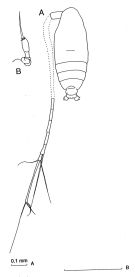 issued from : J.M. Bradford-Grieve in The Marine Fauna of New Zealand: Pelagic Calanoid Copepoda. National Institute of Water and Atmospheric Research (NIWA). New Zealand Oceanographic Institute Memoir, 102, 1994. [p.62, Fig.32]. Female: A, habitus (dorsal); B, P5.
|
 Issued from: M.G. Mazzocchi, G. Zagami, A. Ianora, L. Guglielmo & J. Hure in Atlas of Marine Zooplankton Straits of Magellan. Copepods. L. Guglielmo & A. Ianora (Eds.), 1995. [p.109, Fig.3.16.1]. Female: A, habitus (dorsal); B, urosome (dorsal); C, P5. Nota: Farran (1936) described P5 3-segmented.
|
 issued from: Q.-c Chen & S.-z. Zhang in Studia Marina Sinica, 1965, 7. [Pl.10, 4-6]. Female (from E China Sea): 4, habitus (dorsal); 5, urosome (dorsal); 6, P5 (posterior).
|
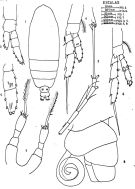 issued from : J. Corral Estrada in Tesis Doct., Univ. Madrid, A-129, Sec. Biologicas, 1970. [Lam.26]. Female (from Canarias Is.): 1, habitus (dorsal); 2, distal segments of A1; 3, P1; 4, P2; 5, endopodal segments of P3; 6, P4; 7, P5; urosome with spermatophore (lateral left side, another specimen).
|
 issued from : J. Corral Estrada in Tesis Doct., Univ. Madrid, A-129, Sec. Biologicas, 1970. [Lam.27]. Male: 1, habitus (dorsal); 2, postrior part cephalothorax and urosome (dorsal); 3, P1; 4, P2; 5, P3; 6, endopodal segments of P4; 7, P5.
|
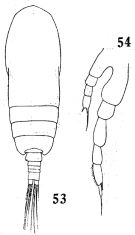 issued from : Q.-c. Chen & S.-z. Zhang in Studia Marina Sinica, 1974, 9. [Pl.5, Figs.53-54]. Male (from South China Sea): 53, habitus (dorsal); 54, P5.
|
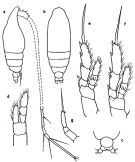 Issued from : G.P. Farran in Great Barrier Reef Expedition 1928-1929, Scient. Rep., V, N°3, 1936. [p.84, Fig.3]. Female: a, habitus (lateral); b, idem (dorsal); c, abdomem (dorsal); d, P1; e, P2; f, P3; g, P5.
|
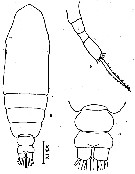 issued from : Z. Zheng, S. Li, S.J. Li & B. Chen in Marine planktonic copepods in Chinese waers. Shanghai Sc. Techn. Press, 1982 [p.26, Fig.13]. Female: a, habitus (dorsal); b, urosome (dorsal); c, P5. Scale bar in mm.
| | | | | Compl. Ref.: | | | Sewell, 1948 (p.322, 418); V.N. Greze, 1963 a (tabl.2); Shmeleva, 1963 (p.141); 1965 b (p.1350, lengths-volume -weight relation); Mazza, 1966 (p.69); Pavlova, 1966 (p.43); Fleminger, 1967 a (tabl.1); Delalo, 1968 (p.137); Park, 1970 (p.475); Björnberg, 1973 (p.307, 384); Shmeleva, 1973 a (p.538); Corral Estrada & Pereiro Muñoz, 1974 (tab.I); Deevey & Brooks, 1977 (p.256, tab.2, Station "S"); Kovalev & Schmeleva, 1982 (p.83); Vives, 1982 (p.290); Guangshan & Honglin, 1984 (p.118, tab.); Greze & al., 1985 (p.7); Almeida Prado Por, 1985 (p.250); Lozano Soldevilla & al., 1988 (p.57); Oliveira Dias, 1995 (p.147); Shih & Young, 1995 (p.71); Webber & al., 1996 (tab.1); Siokou-Frangou, 1997 (tab.1); Alvarez-Cadena & al., 1998 (tab.3); Suarez-Morales & Gasca, 1998 a (p108); Hure & Krsinic, 1998 (p.20, 100); Noda & al., 1998 (p.55, Table 3, occurrence); Mauchline, 1998 (tab.30); Siokou-Frangou & al., 1999 (p.205, Table 5); Neumann-Leitao & al., 1999 (p.153, tab.2); Razouls & al., 2000 (p.343, Appendix); Ueda & al., 2000 (tab.1); Hwang & al., 2003 (p.193, tab.2); Shimode & Shirayama, 2004 (tab.1, 2); Hsieh & al., 2004 (p.397, tab.1); Lo & al.*, 2004 (p.218, fig.6); Lo & al., 2004 (p.468, tab.2); Chang & Fang, 2004 (p.456, tab.1); Lan & al., 2004 (p.332, tab.1); Zuo & al., 2006 (p.163: tab.1); Prusova & Smith, 2005 (p.75); Isari & al., 2006 (p.241, tab.II); Hwang & al., 2006 (p.943, tabl. I) ; Sterza & Fernades, 2006 (p.95, Table 1, occurrence); Dias & Araujo, 2006 (p.60, Rem., chart); Kovalev, 2006 (p.67: Lessepsian migration); Hwang & al., 2007 (p.23); Dur & al., 2007 (p.197, Table IV); Khelifi-Touhami & al., 2007 (p.327, Table 1); Biancalana & al., 2007 (p.83, Tab.2, 3); Neumann-Leitao & al., 2008 (p.799: Tab.II, fig.6); Morales-Ramirez & Suarez-Morales, 2008 (p.518); Tseng L.-C. & al., 2008 (p.153, Table 2, fig.5, occurrence vs geographic distribution, indicator species); Fernandes, 2008 (p.465, Tabl.2); Galbraith, 2009 (pers. comm.); Miyashita & al., 2009 (p.815, Tabl.II); Dias & al., 2010 (p.230, Table 1); Mazzocchi & Di Capua, 2010 (p.426); Medellin-Mora & Navas S., 2010 (p.265, Tab. 2); W.-B. Chang & al., 2010 (p.735, Table 2, abundance); Kâ & Hwang, 2011 (p.155, Table 3: occurrence %); Tseng L.-C. & al., 2011 (p.47, Table 2, occurrences vs mesh sizes); Selifonova, 2011 a (p.77, Table 1, alien species in Black Sea); Isari & al., 2011 (p.51, Table 2, abundance vs distribution); Uysal & Shmeleva, 2012 (p.909, Table I); Jang M.-C & al., 2012 (p.37, abundance and seasonal distribution); Gubanova & al., 2013 (in press, p.4, Table 2); in CalCOFI regional list (MDO, Nov. 2013; M. Ohman, pers. comm.); Lidvanov & al., 2013 (p.290, Table 2, % composition); Terbiyik Kurt & Polat, 2013 (p.1163, Table 2, fig.9, seasonal distribution); Hwang & al., 2014 (p.43, Appendix A: seasonal abundance); Bonecker & a., 2014 (p.445, Table II: frequency, horizontal & vertical distributions); Mazzocchi & al., 2014 (p.64, Table 3, 4, 5, spatial & seasonal composition %); Nakajima & al., 2015 (p.19, Table 3: abundance); Dias & al., 2015 (p.483, Table 2, abundance, biomass, production, Table 4: % vs. season); Benedetti & al., 2016 (p.159, Table I, fig.1, functional characters); Benedetti & al., 2018 (p.1, Fig.2: ecological functional group); Belmonte, 2018 (p.273, Table I: Italian zones); Dias & al., 2018 (p.1, Table 2: vertical distribution, abundance vs. season); | | | | NZ: | 15 | | |
|
Distribution map of Calocalanus pavoninus by geographical zones
|
| | | | | | | | | | | | | | |  issued from : A.A. Shmeleva in Bull. Inst. Oceanogr., Monaco, 1965, 65 (n°1351). [Table 6: 10 ]. Calocalanus pavoninus (from South Adriatic). issued from : A.A. Shmeleva in Bull. Inst. Oceanogr., Monaco, 1965, 65 (n°1351). [Table 6: 10 ]. Calocalanus pavoninus (from South Adriatic).
Dimensions, volume and Weight wet. Means for 50-60 specimens. Volume and weight calculated by geometrical method. Assumed that the specific gravity of the Copepod body is equal to 1, then the volume will correspond to the weight. |
| | | | Loc: | | | sub-Antarct (SW & SE Pacif.), Ushuaia, Straits of Magellan (Pacific and Central area), S Cape Verde Is., Canary Is., Morocco-Mauritania, Brazil (S, Campos Basin, Vitoria Bay, off Vitoria-Cabo de Sao Tomé, off Natal), Caribbean Sea, Jamaica, Caribbean Colombia, Yucatan, G. of Mexico, Florida, off Bermuda: Station "S" (32°10'N, 64°30'W), Sargasso Sea, Brazil-Argentina, Campos Basin, Medit. (Alboran Sea, W Basin, N Tunisia, N Tyrrhenian Sea, Adriatic Sea, Ionian Sea, Aegean Sea, Thracian Sea, Cretan Sea, Iskenderun Bay, Lebanon Basin, Black Sea), Red Sea, Arabian Sea, Indian, Bay of Bengal, Tioman Is. (Malaysia) after Nakajima & al., China Seas (East China Sea, South China Sea), Taiwan (S, W, SW, Tapong Bay, Kaohsiung Harbor, NW, NE), Korea Strait, Japan (Kuchinoerabu Is., Izu), Pacif. (W equatorial), Australia (Great Barrier, Shark Bay), off NW New Zealand, Oregon, California, G. of California, W Costa Rica, Chile | | | | N: | 105 | | | | Lg.: | | | (34) F: 0,71; (36) F: 0,76-0,71; (55) F: 0,72; (180) F: 0,7-0,64; M: 0,5; (196) F: 0,63; (202) F: 0,64-0,72; M: 0,48; (290) F: 0,72-0,7; (332) F: 0,97-0,65; (338) M: 0,55-0,5; (866) F: 0,6-0,7; M: 0,5-0,6; (1023) F: 0,71; {F: 0,60-0,97; M: 0,50-0,60} | | | | Rem.: | epipelagic. Sargasso Sea: 0-500 m.
The species resembles C. contractus.
After Benedetti & al. (2018, p.1, Fig.2) this species belonging to the functional group 4 corresponding to small filter feeding herbivorous and mixed feeding omnivorous (mostly broadcasters). | | | Last update : 12/07/2020 | |
|
|
 Any use of this site for a publication will be mentioned with the following reference : Any use of this site for a publication will be mentioned with the following reference :
Razouls C., Desreumaux N., Kouwenberg J. and de Bovée F., 2005-2025. - Biodiversity of Marine Planktonic Copepods (morphology, geographical distribution and biological data). Sorbonne University, CNRS. Available at http://copepodes.obs-banyuls.fr/en [Accessed July 03, 2025] © copyright 2005-2025 Sorbonne University, CNRS
|
|
 |
 |











